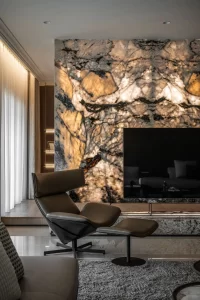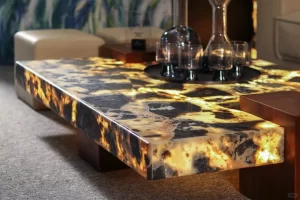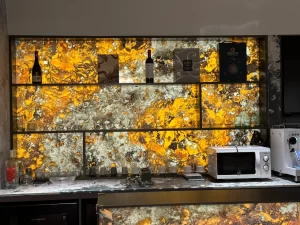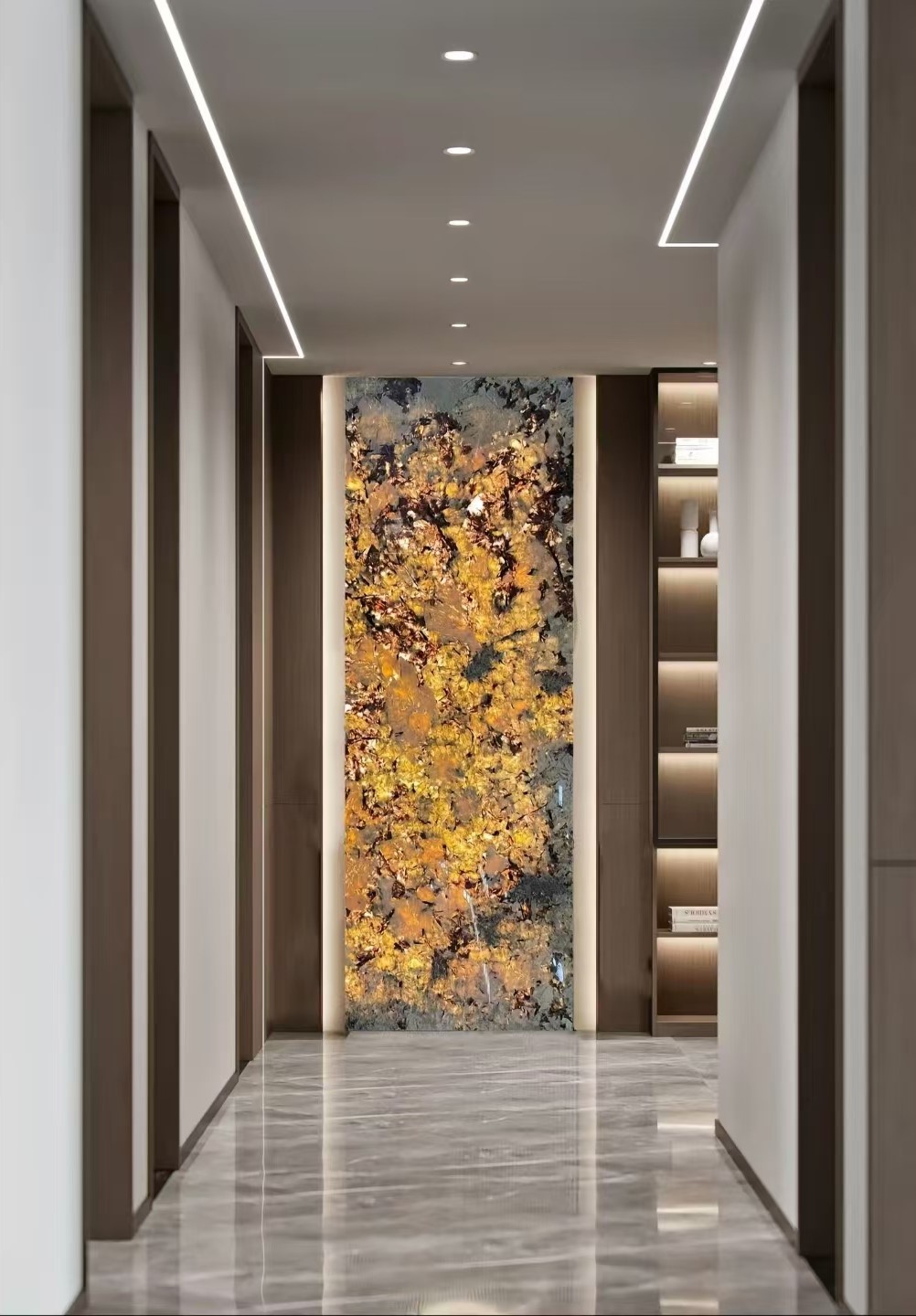In modern design, the term “backlit stone” appears more and more frequently in people’s vision. Backlit stone’s distinctive visual effects and creative appeal have drawn many people’s attention whether in opulent hotel lobbies or in high-end house design. So, what kind of stones can be backlit? Can natural quartz, being a common stone, also exhibit interesting light and shadow phenomena under the microscope? With this question, we will explore the potential and application of natural quartz as a backlit stone in depth.

backlit stone is used for light and shadow in interior decoration
Characteristics of natural quartz and standards of backlit stone
First, we need to understand what kind of stone is suitable as a backlit stone. Usually with a specific degree of light transmittance, backlit stone can highlight the texture and colour changes within the stone under the action of the light source. Stone’s light transmittance often depends on its mineral composition, density of texture and thickness. In backlit effect, stones with strong light transmittance—marble, jade, agate—often provide fantastic visual experience.
So, does natural quartz meet these conditions? Mostly made of silicon dioxide (SiO2), natural quartz is a quite hard crystal. Its crystal structure is very tight, so its light transmittance is low. Natural quartz lacks known light transmittance when compared to marble or jade. Natural quartz is not therefore appropriate for use as a backlighting stone in its natural state.
Difference between natural quartz and quartzite
When discussing whether natural quartz can be backlit, we often encounter another related question: What is the difference between natural quartz and quartzite? Though many people mix the two, backlit stones are actually used in somewhat different ways.
Natural quartz is a widely existing mineral in nature. It may have a modest amount of light transmittance when it has great transparency and purity, but its structure’s compactness limits this light transmittance somewhat severely. Quartzite is an artificial stone, usually made of about 90% quartz powder mixed with resin and other additives. By modifying the formula and technique, especially those thinner quartzite slabs, which are more suited for usage as backlighting stones, quartzite can be produced to have a certain light transmittance during manufacturing. Consequently, in the use of backlit stone, quartz is significantly more widespread than in nature.

Backlit stone for tabletops
Discussion on the practical application of whether natural quartz can be backlit
Although natural quartz is not a typical backlit stone, it can still achieve the backlit effect through some technical means under certain conditions. For instance, it could have a particular light-transmitting effect if natural quartz is chopped thin enough and the quartz crystal component with more transparency is chosen. Usually, this backlit effect is more restricted and cannot create the startling visual impact of marble, jade and other stones.
In addition, the hardness and durability of natural quartz make it very suitable for use as countertops, floors and other occasions that need to withstand high wear. But in these uses, light transmittance is not the primary factor; so, natural quartz is more thought of as a durable stone than a backlit stone here.
Alternatives to other backlit stones
For designers and consumers who pursue backlit effects, if natural quartz cannot meet the light transmittance requirements, other stones with better light transmittance can be considered. Because of their inherent light transmittance and elegant texture, stones including marble, jade, and agate hold a significant role in the use of backlit stone.
The transparency of marble makes it a classic choice for backlit stone, especially in high-end hotels and luxury homes, where backlit marble is often used to create luxurious decorative effects. Especially in bespoke art installations and high-end decorations, backlit jade is even more exceptional since Jade exhibits a particular appeal in the field of backlit stone with its unique texture and colour shifts.
Agate, with its rich colors and layering, is widely used in occasions that require artistic sense, such as lighting design and wall decoration. Under the reflection of light, backlit agate can exhibit a dreamy quality that provides people with a lovely visual delight.

Backlit stone counter decorated with translucent stone
In summary, natural quartz is not an ideal backlit stone. While under some situations it can attain a certain degree of light transmission, the backlit effect of natural quartz is still somewhat limited when compared to other stones such marble, jade and agate. If you are looking for a significant backlight effect, it is recommended to choose stones that are naturally highly translucent, or artificial stones such as quartz that have been specially processed. The choice of backlit stone reflects not only the substance but also a thorough awareness of the design influence and application situations.
Frequently Asked Question (FAQ)
Which stones glow?
Marble, a popular building and decorative stone, is known for its elegant light and shadow effect, making it suitable for various designs.
Agate, a colorful magic stone, is known for its intricate textures and rich color layers, making it popular in architecture and design.
Quartzite, a translucent stone, is a popular choice for kitchen counters and bathroom walls due to its transparency and durability.
Jade, a symbol of authority and prestige, is also a fascinating translucent stone with its warm luster.
Granite, a delicate solidity stone, has translucent properties, making it suitable for floor and wall decoration.
Flint, an ancient stone, is known for its low-key brightness and is often used in tools and weapons.
Kyanite, a dreamy blue light, is a fascinating translucent stone with its unique properties.





